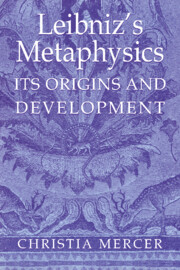Book contents
- Frontmatter
- Contents
- Acknowledgments
- References to Leibniz's works
- Introduction: first truths and half truths
- PART ONE METAPHYSICS OF METHOD
- PART TWO METAPHYSICS OF SUBSTANCE
- PART THREE METAPHYSICS OF DIVINITY
- PART FOUR METAPHYSICS
- 7 Matter, passivity, and panorganic vitalism, 1670–71
- 8 Phenomenalism and Preestablished Harmony, 1671
- 9 Preestablished Harmony, late 1671–early 1672
- 10 Final steps toward the mature philosophy, 1672–79
- Conclusion: the truth behind the First truths
- Appendix I (Not exactly) First truths
- Appendix II Leibniz's original assumptions
- Bibliography
- Index Locorum
- Index
7 - Matter, passivity, and panorganic vitalism, 1670–71
from PART FOUR - METAPHYSICS
Published online by Cambridge University Press: 12 March 2010
- Frontmatter
- Contents
- Acknowledgments
- References to Leibniz's works
- Introduction: first truths and half truths
- PART ONE METAPHYSICS OF METHOD
- PART TWO METAPHYSICS OF SUBSTANCE
- PART THREE METAPHYSICS OF DIVINITY
- PART FOUR METAPHYSICS
- 7 Matter, passivity, and panorganic vitalism, 1670–71
- 8 Phenomenalism and Preestablished Harmony, 1671
- 9 Preestablished Harmony, late 1671–early 1672
- 10 Final steps toward the mature philosophy, 1672–79
- Conclusion: the truth behind the First truths
- Appendix I (Not exactly) First truths
- Appendix II Leibniz's original assumptions
- Bibliography
- Index Locorum
- Index
Summary
In November 1671, Leibniz wrote his first letter to the great Antoine Arnauld. While the correspondence between Leibniz and Arnauld that dates from the 1680s is surely one of the most fascinating philosophical exchanges in seventeenth-century philosophy, it is not entirely surprising that Arnauld did not respond to our young German's first attempt at communication. The letter of 1671 is long, tedious, and obscure. But the very features that probably repelled Arnauld make the letter enormously significant for us. It stands as elaborate proof of Leibniz's genuine and persistent concern with theological issues. It also presents one of the reasons that the young man had in the months before his departure for Paris to deny the reality of passive matter.
In this chapter, I turn to Leibniz's early views about matter and passivity. Between 1663 and 1668, Leibniz believed that there was primary passive matter, what I called body qua matter in chapters 2, 3 and 4. He conceived the contribution that primary matter makes to a corporeal substance in terms consistent with his understanding of the Aristotelian philosophy: body qua matter has a nature or essence – roughly, extended inert stuff – that is organized by the substantial form or active principle so as to constitute the nature of a corporeal substance.
- Type
- Chapter
- Information
- Leibniz's MetaphysicsIts Origins and Development, pp. 255 - 299Publisher: Cambridge University PressPrint publication year: 2001



